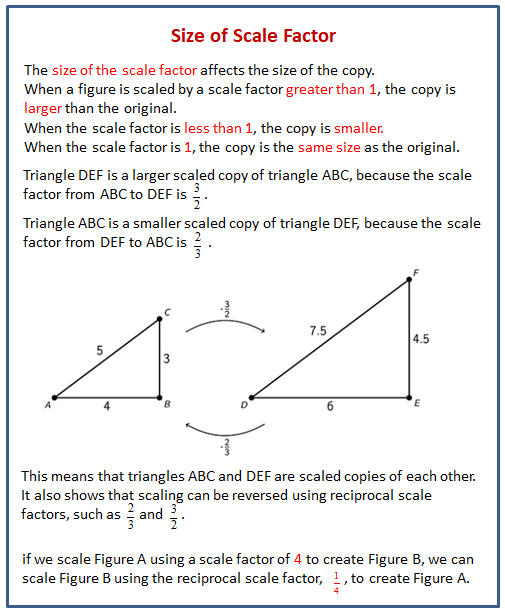Illustrative Mathematics Grade 7, Unit 1, Lesson 5: The Size of the Scale Factor
Learning Targets:
- I can describe the effect on a scaled copy when I use a scale factor that is greater than 1, less than 1, or equal to 1.
- I can explain how the scale factor that takes Figure A to its copy Figure B is related to the scale factor that takes Figure B to Figure A.
Related Pages
Illustrative Math
Grade 7
Lesson 5: The Size of the Scale Factor
Let’s look at the effects of different scale factors.
Illustrative Math Unit 7.1, Lesson 5 (printable worksheets)
Lesson 5 Summary
The following diagram shows how the scale factor that takes Figure A to its copy Figure B is a reciprocal to the scale factor that takes Figure B to Figure A.

Lesson 5.1 Number Talk: Missing Factor
Solve each equation mentally.
16x = 176
16x = 8
16x = 1
1/5 x = 1
2/5 x = 1
Lesson 5.2 Scaled Copies Card Sort
Your teacher will give you a set of cards. On each card, Figure A is the original and Figure B is a scaled copy.
- Sort the cards based on their scale factors. Be prepared to explain your reasoning.
- Examine cards 10 and 13 more closely. What do you notice about the shapes and sizes of the figures? What do you notice about the scale factors?
- Examine cards 8 and 12 more closely. What do you notice about the figures? What do you notice about the scale factors?
Are you ready for more?
Triangle B is a scale copy of Triangle A with scale factor 1/2.
- How many times bigger are the side lengths of Triangle B when compared with Triangle A?
- Imagine you scale Triangle B by a scale factor of 1/2 to get Triangle C. How many times bigger will the side lengths of Triangle C be when compared with Triangle A?
- Triangle B has been scaled once. Triangle C has been scaled twice. Imagine you scale triangle A n times to get Triangle N, always using a scale factor of 1/2. How many times bigger will the side lengths of Triangle N be when compared with Triangle A?
Lesson 5.3 Scaling A Puzzle
Your teacher will give you 2 pieces of a 6-piece puzzle.
- If you drew scaled copies of your puzzle pieces using a scale factor of 1/2, would they be larger or smaller than the original pieces? How do you know?
- Create a scaled copy of each puzzle piece on a blank square, with a scale factor of 1/2.
- When everyone in your group is finished, put all 6 of the original puzzle pieces together like this:
Next, put all 6 of your scaled copies together. Compare your scaled puzzle with the original puzzle. Which parts seem to be scaled correctly and which seem off? What might have caused those parts to be off? - Revise any of the scaled copies that may have been drawn incorrectly.
- If you were to lose one of the pieces of the original puzzle, but still had the scaled copy, how could you recreate the lost piece?
Lesson 5.4 Missing Figure, Factor, or Copy
- What is the scale factor from the original triangle to its copy? Explain or show your reasoning.
- The scale factor from the original trapezoid to its copy is 2. Draw the scaled copy.
- The scale factor from the original figure to its copy is 3/2. Draw the original figure.
- What is the scale factor from the original figure to the copy? Explain how you know.
- The scale factor from the original figure to its scaled copy is 3. Draw the scaled copy.
Lesson 5 Practice Problems
- Rectangles P, Q, R, and S are scaled copies of one another. For each pair, decide if the scale factor from one to the other is greater than 1, equal to 1, or less than 1.
a. from P to Q
b. from P to R
c. from Q to S
d. from Q to R
e. from S to P
f. from R to P
g. from P to S - Triangle S and Triangle L are scaled copies of one another.
a. What is the scale factor from S to L?
b. What is the scale factor from L to S?
c. Triangle M is also a scaled copy of S. The scale factor from S to M is 3/2. What is the scale factor from M to S? - Are two squares with the same side lengths scaled copies of one another? Explain your reasoning.
- Quadrilateral A has side lengths 2, 3, 5, and 6. Quadrilateral B has side lengths 4, 5, 8, and 10. Could one of the quadrilaterals be a scaled copy of the other? Explain.
- Select all the ratios that are equivalent to the ratio 12:3. Explain how you know.
a. 6:1
b. 1:4
c. 4:1
d. 24:6
e. 15:6
f. 1,200:300
g. 112:13
The Open Up Resources math curriculum is free to download from the Open Up Resources website and is also available from Illustrative Mathematics.
Try the free Mathway calculator and
problem solver below to practice various math topics. Try the given examples, or type in your own
problem and check your answer with the step-by-step explanations.

We welcome your feedback, comments and questions about this site or page. Please submit your feedback or enquiries via our Feedback page.